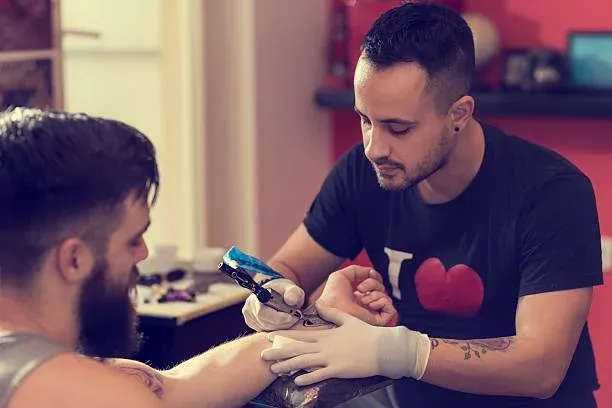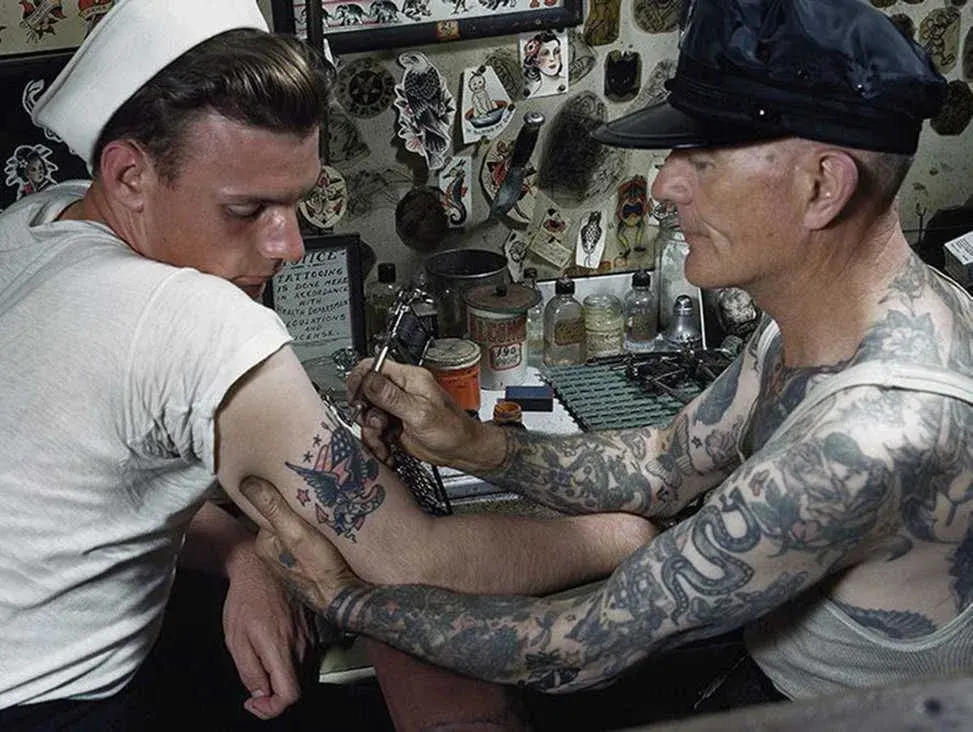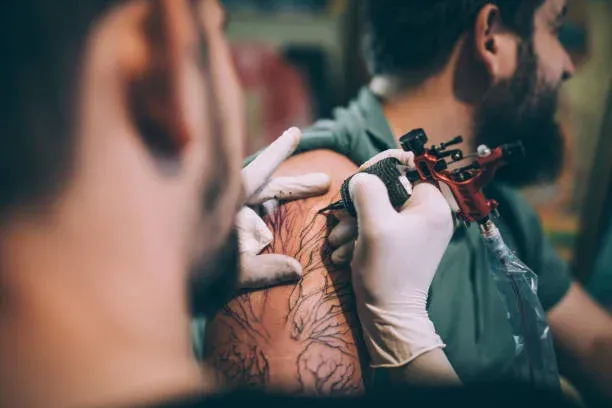Navigating the decision to get a tattoo when grappling with an STD involves weighing risks such as bacterial infections, blood loss, and potential scars against the desire for body art.
In America, the surge in STDs resulting from unprotected sex has prompted a critical question: ‘Can I get a tattoo if I have an STD?’
This issue necessitates a thorough exploration of health requirements, as individuals grapple with concerns about the safety of getting a tattoo amid the rising prevalence of STDs.”
Assessing one’s health condition and understanding the possibility of safely acquiring a tattoo are paramount, requiring careful consideration and professional consultation.
Also Read: The Ultimate Guide To Understanding How Long Till A Red Ink Tattoo Fades
Can I Get A Tattoo If I Have An STD?
Deciding to get a tattoo when you have an STD necessitates careful consideration of your health condition.
The tattoo artist must use sterilized equipment and ink to prevent any risk of infection.
Given the circumstances, each session requires an assessment of how well you can heal.
The tattooing procedure, involving a needle piercing the dermis layer of skin, can be especially painful and lead to blood loss.
For those feeling sick, the healing phase might bring additional discomfort, including inflammation, itchiness, and scabbing.
Proper medication and being cured or having the disease under control are essential to get into the right shape for a tattoo.
Also Read: 7 Best Stick And Poke Ink Alternatives
Gap Between Tattoo Sessions If You Have STD
When managing an STD, the tattoo healing process may be slower, affecting the gap between multiple sessions.
Typically, a 21-28 days wait is advisable, but with delayed healing, extending it to at least a month becomes necessary.
The condition of the first layer of skin and advice from both your doctor and tattoo artist will dictate the session break length.
A weak immunity might increase the risk of infection and other health issues, necessitating longer breaks to ensure wounds heal properly.
Attention to the immune system, along with managing inflammation, pain, itchiness, and scabbing, determines the length of breaks between sessions.
Also Read: What Ink To Use For Stick And Poke

3 Factors To Consider Before Getting A Tattoo If You Have An STD
When contemplating whether to get a tattoo while managing an STD, there are a few factors you should consider.
1. Health Condition
Before embarking on the tattooing procedure, assess if your health condition is at its peak.
A healthy body is crucial, as the process can be tiresome and the healing phase particularly exhausting.
Consult your doctor, adhere to prescribed medication, and follow all dos and don’ts to ensure you are physically and mentally fit. Only proceed if you’re in good enough health.
2. Current STD Condition
Evaluate your STD’s current condition. Thanks to modern medicine, diseases like trichomoniasis, syphilis, chlamydia, and gonorrhea can be cured.
However, for chronic infections such as herpes simplex virus, hepatitis B, human papillomavirus, and HIV, achieving control over the infection and working to boost health is essential.
Ensure your condition is well-managed or cured to maintain good health.
Also Read: What To Wear When Getting A Hip Tattoo
3. Professionalism Of The Tattoo Artist
The professionalism of your tattoo artist is paramount, especially when you are an STD patient.
A professional ensures you feel comfortable, uses sterilized equipment, and avoids unsterile equipment to prevent the spread of STD infection.
It’s crucial for the artist to be careful not only for the client’s safety but also to maintain a sterile environment.
Possibility Of A Tattoo Artist Getting Infected While Tattooing An STD Patient
The possibility of a tattoo artist getting infected while tattooing an STD patient is minimal if proper precautions are taken.
STDs primarily spread through sexual intercourse, including oral, anal, or vaginal sex, and not through casual contact.
Proper sterilize equipment usage and ensuring no open wounds are present on the artist’s body significantly reduce any risk.
Intact skin acts as a barrier against blood-borne pathogens.
Also Read: How Does Tattoo Removal Work
4 Steps To Follow Before Getting A Tattoo If You Have An STD
Ensuring safety and health for those considering tattoos under special circumstances:
1. Consult With Your Doctor
It’s mandatory to ensure you’re in good shape for a tattoo.
Your doctor will assess your health condition and physical condition, providing guidance on whether it’s safe to proceed based on your specific STD.
This step helps mitigate any potential health issues related to the tattooing process.
2. Communicate With Your Tattoo Artist
Full transparency with your tattoo artist about your STD is crucial. Hiding such secrets can be harmful to both you and the artist.
A professional artist who is educated on handling delicate matters involving STD patients can take appropriate precautions to avoid contamination and infection.
3. Ensure Equipment Is Sterilized
Confirm that your tattoo artist uses sterilized equipment and new ink pods for each client.
This step is vital to prevent the transmission of bacteria and other pathogens.
A reputable artist will understand the importance of maintaining a sterile environment to protect all clients from potential infections.
Also Read: Are Colored Tattoos More Expensive
4. Seek A Specialized Professional
Look for an artist who specializes in working with atypical cases and has received training on blood born diseases.
Some artists might have certification from recognized organizations like the Red Cross, indicating they’ve completed courses in safely tattooing individuals with Herpes, HIV, or other blood-borne diseases.
Doing your research to find such a specialist can make the tattooing process safer and more comfortable for you.
What Is The Possibility Of Getting STD From Tattooing?
The risk of transmitting an STD through tattooing is low if sterilized equipment is used.
However, using unsterilized tattoo equipment can spread blood-borne diseases like HIV, hepatitis B, and C.
Always ensure that needles, ink pods, and the tattoo bench are properly disinfected as a vital precaution.
Also Read: Is Laser Tattoo Removal Painful

FAQs About Can I Get A Tattoo If I Have An STD
1. Can I Get A Tattoo Anywhere I Want If I Have An STD?
Yes, but consult your doctor and tattoo artist first. Some body parts may be more sensitive or risky depending on your STD.
2. Do I Have To Tell My Tattoo Artist That I Have STD?
Absolutely. Sharing this vital information with your tattoo artist helps prevent issues and ensures they don’t inadvertently transmit bacteria to other clients.
3. Can I Become A Tattoo Artist If I Have An STD?
Yes, having an STD does not disqualify you from becoming a tattoo artist. Proper hygiene and safety practices are key.
4. Can You Get A Tattoo If You Have Syphilis?
Syphilis was historically transmitted via tattoos in the nineteenth century, often through tattooists with syphilitic lesions. Today, understanding and managing primary syphilis is crucial before proceeding.
5. What Happens If You Get A Tattoo While On Antibiotics?
Taking antibiotics increases the risk of infection and can interfere with how a tattoo heals due to foreign antibodies fighting the tattoo pigment.
6. Is Getting A Tattoo Bad For Your Immune System?
Frequent tattoos may actually boost the immune system, increasing immune molecules and antibodies in the blood.
7. What Are The Negative Side Effects Of Tattoos?
Tattoos can lead to infections, systemic infections, allergic reactions, photodermatitis, granulomatous reactions, lichenoid reactions, and exacerbate skin diseases like eczema, psoriasis, lichen planus, and morphea in the tattooed area.
Final Thoughts
In conclusion, the question “can i get a tattoo if i have an STD” encompasses a nuanced decision-making process that requires careful consideration of one’s health, the specialized knowledge of the tattoo artist, and the specifics of the skin disease.
Consulting with a doctor for professional advice, understanding the training required for tattooing special needs clients, and ensuring both cured and incurable conditions are optimally managed are key steps.
Adequate breaks between sessions, a strong immune system, and a commitment to heal properly must guide those seeking tattoos under these circumstances.
